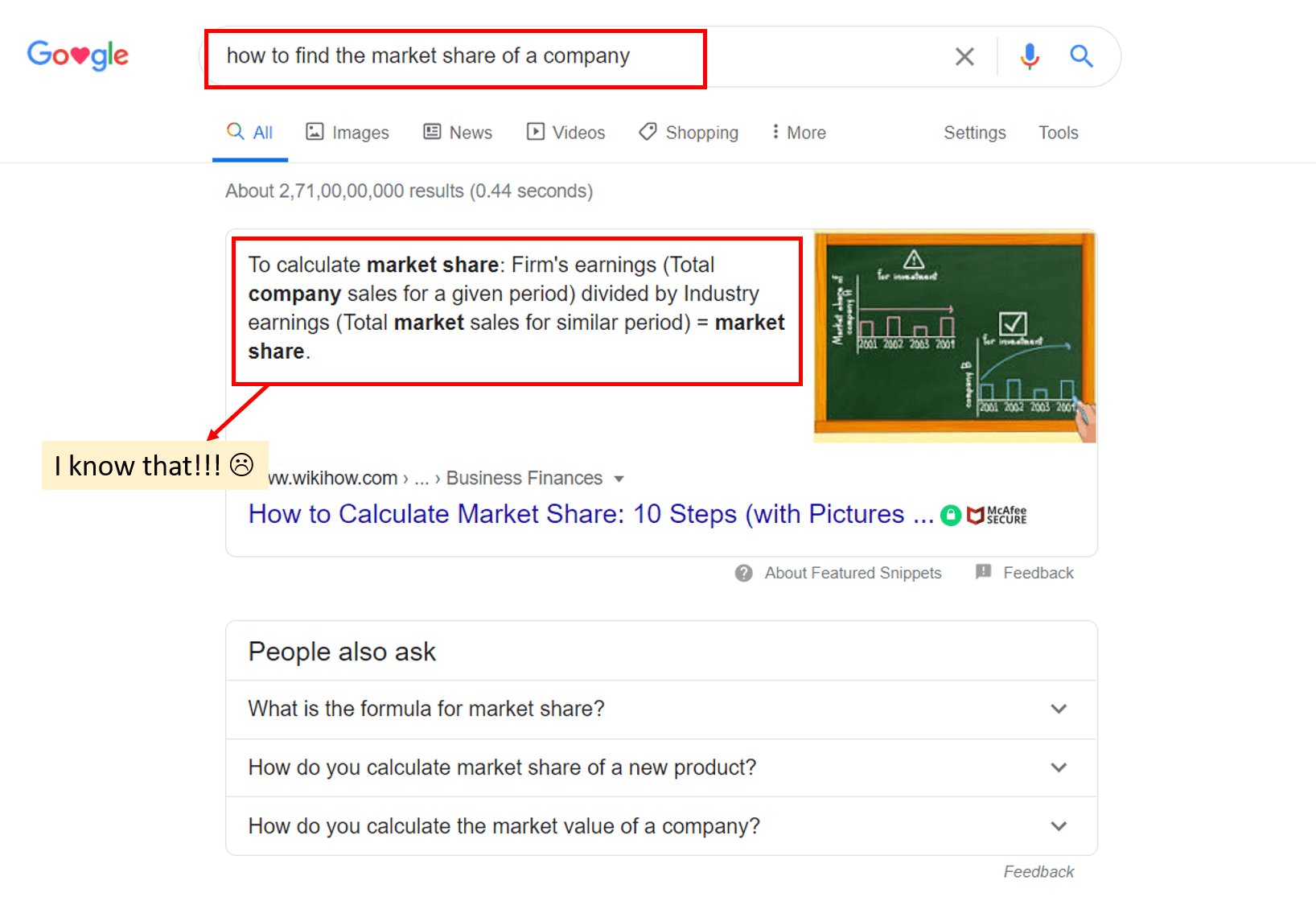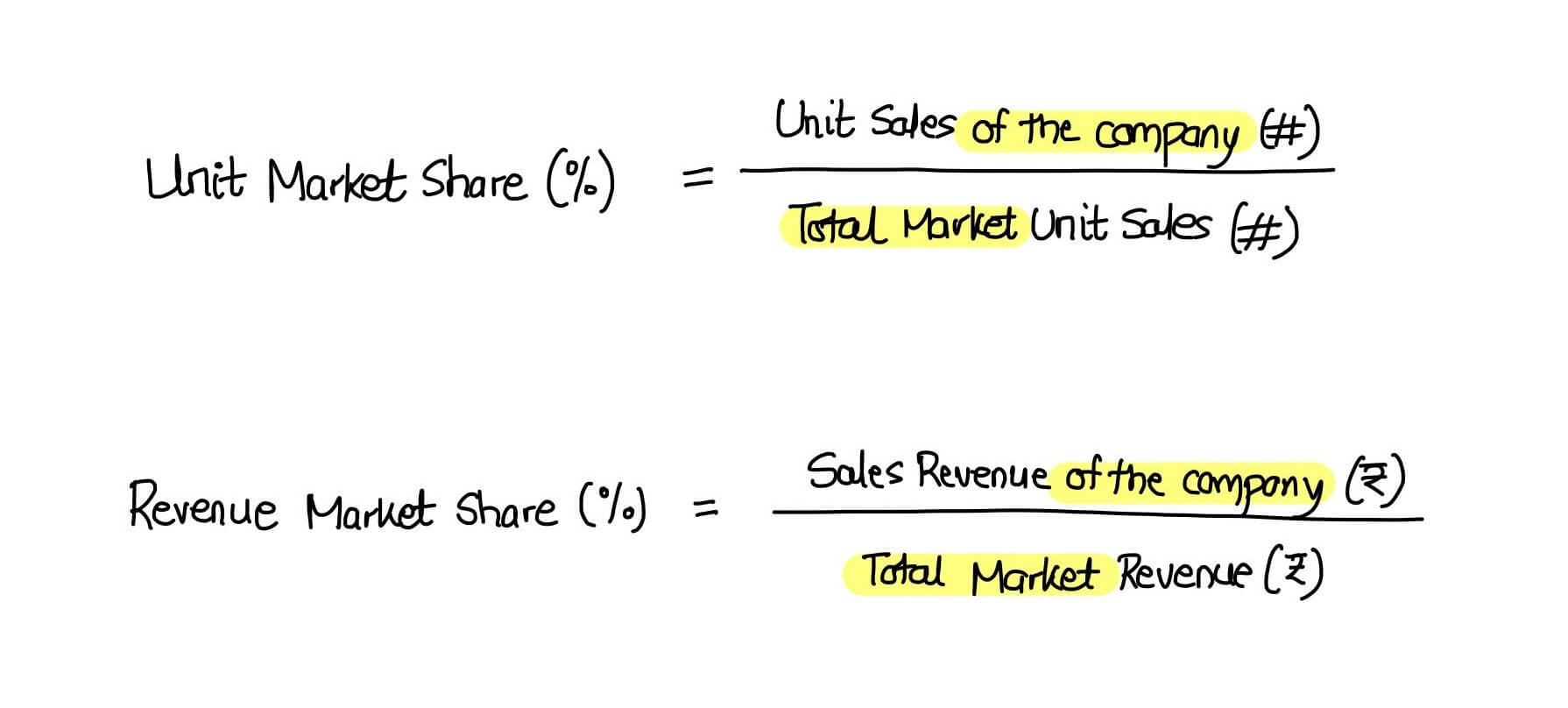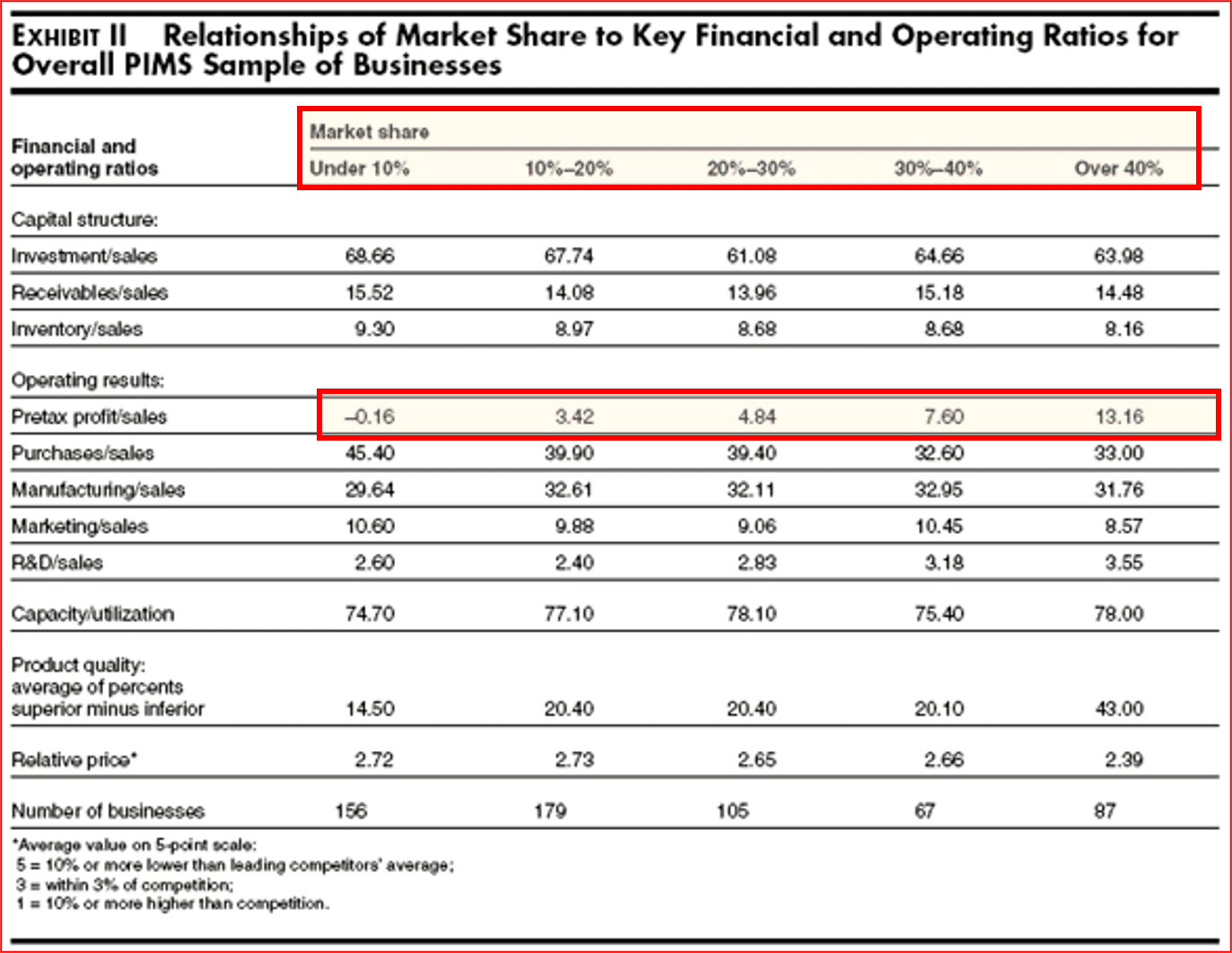
A very significant variable for companies, investors and business analysts today is market share. You as a marketer are aware of the pre-requisites for any business plan. It is to find the market share of your competitors (and even of your company). You may face the obvious doubt - how to find the market share of a company?
So, you do a Google search to find the market share of a competitor. You calculate the total size of your market. I did the same for so many projects at my B-school. I opened Google, with a lot of hope and typed “How to find the market share of a company?”.
And all I could find in even some of the best marketing websites & blogs were mere definitions & formulas. Such as- “how to find the market share of a company?” Facepalm.

Therefore, I decided to put this up on my blog. It was partially as a rant and partially as a help for anyone else like me who is out there. For people trying hard to know how to find the market share of a company.
I will give you a brief insight into market share. My focus will be on exploring what is market share primarily. Furthermore, what is the significance of market share and how to measure it.
I will also discuss about things like whether an organization should really bother about the market share or not. In subsequent discussions, I will also share strategies for protecting and increasing the market share of a company.
What is Market Share?
As defined in Marketing Management book by Philip Kotler, market share is the higher-level of specific demand for your product.
Each company operates in a particular marketing environment, in a market segment with a particular set of products. Therefore, the market share of a product determines the demand for that particular product, in a particular market segment, given a particular marketing environment in a definite time period.
In the most simplest terms, as mentioned in this another insightful book on marketing metrics, the answer to what is market share might look to be something as simple as “us/(us + they)”. But what exactly do we need to figure out here? Who is the “us” (which of our business, product category, or product) and who are “they” (which is determined by the market segment).
Mathematically, this market share definition comes up in two ways.
One is market share by units, and the other one is market share by revenue.

These market share formula, mathematically, suggest the answer to what is market share. Market share is the percentage of a specific company's sales (either in terms of units or revenue) out of total sales in a market over a specific time period.
Now, exactly where in the market value chain would you calculate the market share?
This is another consideration that you need to be mindful off. I will discuss it later when I would share how to find the market share of a company.
Market Share Revenue or Volume
The market share can be measured in volume (units) or in terms of revenue (₹ or $). Market share by volume or units would give the percentage of the number of units of a product sold by a company over the total number of units of that product (or similar products, as defined by you) sold in the industry.
Now, market share by revenue implies sales percentage of a company against the total dollars earned by the entire industry.
Both of these are hardly ever the same. Simple heuristics would tell you that competitive pricing could result in lower market share by revenue when compared with the market share by volume. We usually calculate market share in terms of revenue.
For service industries, we measure only revenue whereas for product-based companies we can calculate both revenue and units.
Importance of Market Share
Understanding market share would be incomplete without knowing the importance & relevance of market share in the marketing landscape. The following points will give you a better understanding of this most used marketing metric.
1. Market Share is linked to better profitability
The market share is one of the main determinants of business profitability. Broadly there are three reasons or explanations of why a high market share is linked to higher profitability.
- Economies of scale: Larger the market share, larger the company. Large companies do achieve better economies of scale in various components of the business.
- More market power: A larger business commands higher market power. This allows it to have better bargaining power and give shape to the market dynamics, pricing.
- Quality of management: A higher market share and better profitability, both, have one underlying reality i.e. the quality of management. Further, bigger companies attract better talent, going forward.
In fact, from a project undertaken by the Marketing Science Institute on the Profit Impact of Marketing Strategies (PIMS) in 1971, suggest this very fact that a higher market share is linked to higher return-on-investment (ROI) and higher profitability.

2. Market Share is an important parameter of market demand
For you as a marketer, estimating the market demand is one of the preliminary exercises. The market share of various companies help in determining the marketing landscape in the given segment. This helps in estimating the company demand leading to better sales forecast.
Various tools such as Excel. SPSS etc are also used to efficiently calculate the sales forecast for a company.
It is likely that your takeaway from this discussion might be this very aspect of business planning. In a lot of business plans and B-schools’ assignments, the initiation point is estimating the market & company demand. For that purpose, market shares of the players become important.
3. Market Share is crucial in non-expansible markets
Non-expansible markets, as the name suggests, are those markets in which the overall market size, or the size of pie, doesn’t increase with the increase in industry marketing expenditure.
This has been quite beautifully explained in the Marketing Management book by Philip Kotler by quoting the example of weekly garbage collection as an example of a non-expansible market.
Therefore, what if you work for a company operating in a market in which the overall pie cannot grow? As a marketer you should accept the primary demand and look for increasing your market share in the pie.
The fact of the matter is that indeed, it is an important factor in identifying a company’s performance. Yet, it is not the only factor.
What does Market Share tell about a Company?
Economic analyses are conducted by measuring and surveying market shares. An increase in a company’s market share shows less competition and high profitability. Elsewhere, a decrease in market share indicates better competition or a lack on the company’s behalf.
However, market share is not the only thing that can tell everything about a company.
There are several factors that we consider in creating a perfect impression.
1. Market share tells you about the profitability of the company
A higher market share improves the profitability of a company as it gives it an edge over its competitors. A company that has the highest share in a market is considered as the market leader. It can expand its profits by increasing prices. It can be used to understand the success of a certain company in any market.
2. Market share tells you about the industry competitiveness
Also, the market share distribution in an industry tells a lot about how competitive the market is. It can reveal a lot about whether the industry is a monopoly, an oligopoly or an industry with a cut-throat competition
Common Myths about Market Share of a Company
However, as a smart marketer, you need to be extremely careful and astute about how you interpret the market share. The fact is that market share is not a tell-all marketing metric. And this is true for pretty much every marketing metric out there.
1. Market share alone might not tell you about who is doing better.
One example can be Amazon and Flipkart. Flipkart had 51% of the market share in the Indian market whereas Amazon had taken up 32% in the year 2018.
But this factor alone cannot tell us how these giants are doing in the market. Amazon started its operations in India in 2013, Flipkart is in the Indian market since 2007. These companies are going head-to-head in the market and as of now, Amazon is closing in fast.
You can understand how Amazon rose to prominence gradually if you go through the SWOT analysis of Amazon.
2. Change in market share might mean nothing in an expansible market
As mentioned above, an expansible market is one where the overall industry expenditure can increase the overall pie. (i.e., the overall market size) What can happen in such a scenario? It’s possible that the business of your company has increased in absolute terms along with a decrease in market share. Why so? Because the overall market size increased in the expansible market.
As you can notice, these factors are critical to the success of any company. Hence it is imperative that you are aware of - how to find the market share of a company?
How to Find the Market Share of a Company?
It is fairly simple to calculate market share. First, calculate the total sales of the company in a time period. Then, calculate the total sales of the market in the same time period, and finally place it in the formula below and voila; you will have your answer.
But only if actually finding the market share would be as simple as that!
Unfortunately, marketing students at B-schools, marketers and consultants have a hard time in finding out the same. And the reason for that is simple. Where do you find all the sales data of the market, let alone of that company?
Heck, if the company is private company instead of a publicly listed one, how do you even find the market share of a private company?
Frankly, I have been through this situation myself not only during my days at my business school, IIM Udaipur, but also during my job. It was painstaking to do searches after searches on Google in trying to find market share.
So, let me share with you a few methods of finding the market share of a company. I would also help with finding out the total market size.
1. Look for Research Reports by appending “PDF” to your Search Query
This makes your search more distilled. You and I know that finding a data point like the market share is not something that would show up on a random blog (like the one you are reading).
Therefore, try to sieve through all the information at first. Afterwards, try and get hold of some reports that would be available in PDF form.
2. Explore SlideShare for Presentations on the Business
There are a ton of presentations out there that B-school students and business professionals create.
Now, here is the thing. Most of them aren’t quotable in your study or business plan.
Why is it so? Because most of them, would not have quoted their sources in the first place. However, such presentations will give you an idea about what the ballpark number could be.
3. Focus on Total Addressable Market instead of Market Size
Assume that you are looking for the market share of a company just to get know the market size. Then my recommendation would be to focus on finding your Total Addressable Market (TAM) instead.
TAM is a usually a simplified calculation. It involves multiplying the price of your product with the number of customers in your segments. This is direct and straight-forward.
Here, you are simply finding the number of customers coming under you target segment(s) and defining your market size accordingly.
4. Use a Representative Sample
This is a technique in common use for quite of lot of B-school projects and partly in industry.
Say you are unable to find the true data for market share of companies in a particular market. What can you come up with in this situation? You can always run a survey right in that segment seeking answers to questions like “Which brand do you use?” or “Which brand are would you go for if you were to buy this product?”.
Finally, the results of this representative can be spelled out as the market share for the company. Obviously, the sample size should be statistically relevant, and all of the people should be from the target segment. Hopefully, you have now gathered the knowledge to answer this – How to find the market share of a company?
Factors Affecting Market Share of a Company
Market share is a representation of a company's performance. Ultimately, the factors that affect performance are the same factors that affect a company's share more or less.
High performing companies work on innovation, customer relationships, efficient hiring practices, even acquiring their competitors. Uber bought Careem, its biggest competitor in the Middle East. Similarly, Amazon acquired Souq.com in the Middle East, as well.
A prime example of market penetration is Ebix, an Atlanta-based software firm, it recently signed an agreement to acquire Indian online travel company Yatra.
Competitor analysis is a key part of surviving in a market. There are a few basic but key elements that immensely affect a company's market share, when done right; these can take a company to the highest levels.
Conclusion
In short, the market share of a company is a measure of its progress or regress depending on an increase or decrease in market share, respectively. Again, I did highlight that it is just one of the measures. Actually, using it to determine the position of a company or a brand may be a futile exercise. I touched down upon relevant methods regarding how to find the market share of a company.
I have tried to highlight that if you are trying to evaluate the market share of a company then you have a few things that you can do which can fill in for the lack of real data.
Also, why don't you come up with creative ways about how to find the market share of a company? Apply the limitation that you can just not get hold of much data. I would be happy to include some of the best ones in the blog.






